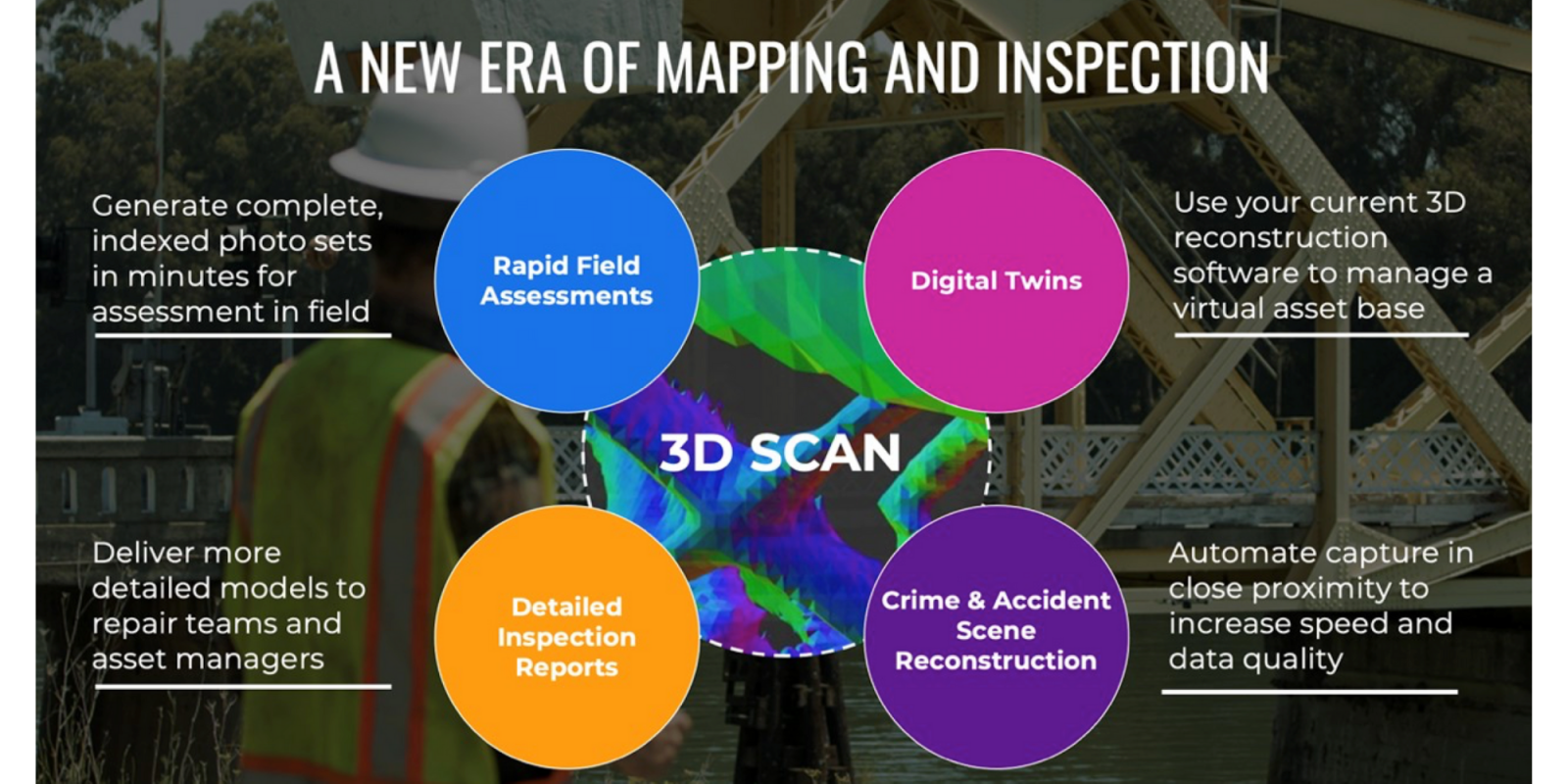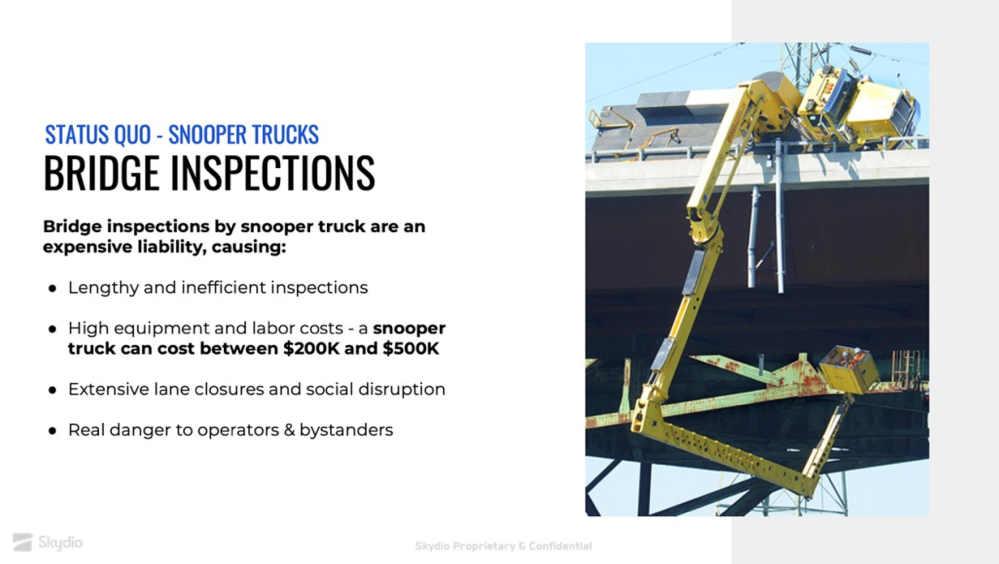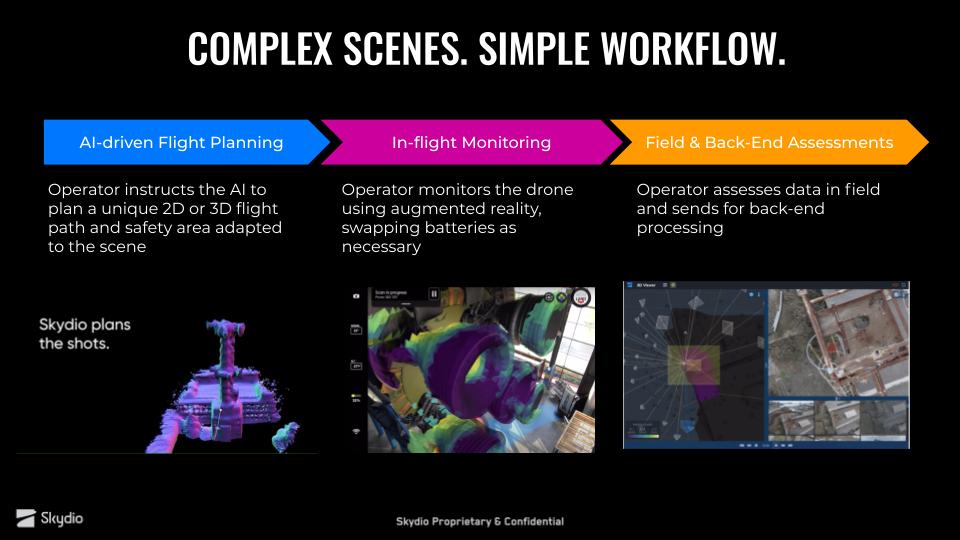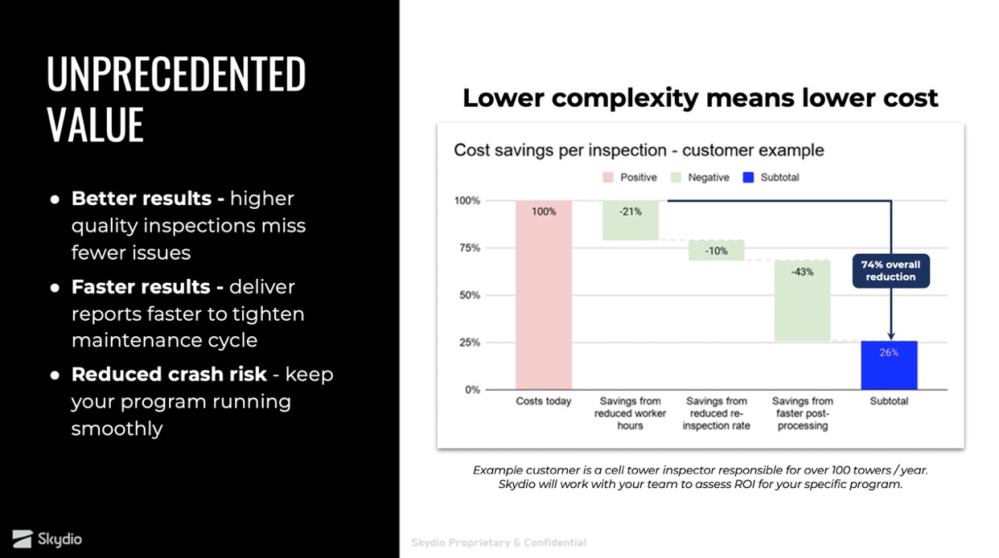
Time flies in the drone world. Just last week, Skydio launched its 3D Scan software with a major online event filmed at the US Space and Rocket Center in Huntsville, Alabama. Thousands attended that presentation, and a lot of people had questions. Today, Skydio put on a webinar to recap the software and answer some of those queries.
Skydio, the leading US Enterprise/consumer drone manufacturer, launched its much-anticipated 3D Scan software June 2. The release of this software into the hands of commercial operations is a very big deal for the company (the software is $2999 per year per drone), and also a very big deal for Enterprise operators in need of a no-fuss, no-muss package that can be easily learned and scaled.
But the June 2 event consisted largely of a lengthy video, including demos of the software in action. There wasn’t really a lot of time for questions. Or, more accurately, there wasn’t really a lot of time for answers. Today, Skydio recapped the software and dove into those answers in an hour-long webinar.
3D Scan is powerful
We’ve had the opportunity to try a Beta version of the software, which was updated for the commercial release June 2. And we were incredibly impressed. If you happened to miss the actual launch event, we highly recommend having a read of this short recap, which includes the launch video.
Today, Skydio pulled together some of its top talent, including CEO and Co-Founder Adam Bry, Customer Success VP Alden Jones (who joined the webinar from a site where he was working with customers), and Hayk Martiros – who was Skydio’s first engineering hire and is now VP of Autonomy.

Questions, questions, questions…
When you’ve got thousands of people on a new product presentation, you’re going to get a lot of questions. Skydio didn’t have the time to answer the many queries that were posted, but moderator Guillaume Delépine did a great job of grouping those questions into broader themes. Guillaume started out by simply asking Adam why Skydio created 3D Scan, which was 18 months in the making.
My audio feed had some hiccups during Adam’s response, but I did catch the nugget that sums it all up.
“It enables you to fly missions that would otherwise be impossible,” he said.

That’s a pretty bold statement. But – and I’ve spoken with a leading photogrammetry engine company about this claim – it’s true. Combining a Skydio drone with 3D Scan software does enable you to scan even highly complex structures (including underneath objects like bridges). And you don’t need to be a highly trained pilot to carry out these missions.
“3D Scan can help you or your organization immediately become experts,” said Alden Jones, who has a ton of field experience overseeing major UAS programs. “It’s an extremely simple workflow: All you’re doing is setting a volume…and the drone will go and explore the scene. There’s nothing else on the market that can capture 3D in this way.”
Key features
So what is it that makes all this tick? That’s a more complicated question. We’ll delve into some basic deets in a bit, but – in addition to this hardware and software combination – it’s about workflow. The step-by-step 3D Scan software truly does make it easy. You simply start by defining a volume, with Augmented Reality cues displaying on your mobile device or tablet to show what you’ve enclosed. Once you’ve done that, the drone and the software do the real work. You can check your photo captures (and a rough 3D model) from the field:

The original slide for this contains a GIF. Normally, you’d see how a Skydio drone scopes out what’s in that volume and plans its shots in that bottom left slot. This is definitely not a standard lawnmower-pattern grid. The drone figures out what it is you want defined, then calculates the necessary flight path to capture all the contours – and the data. And then…it simply does it.
“With real-time AR coverage,” said Alden, “you know you’re going to get the model that you want.”
Because the Skydio has true 360° obstacle avoidance, it can get very close to the subject. That means its 12 MP camera can capture data at sub-millimetre Ground Sampling Distance resolution.
Is 3D Scan for me?
That was one of the common themes in the question queue the previous week. What kind of structures can it scan? How big? How small?
“There’s a large class of structures where it works well,” said Hayk Martiros, the VP of Autonomy. But he pointed out, as with any drone, there are limitations. The Skydio doesn’t always do well with thin wires or thin branches, so Martiros recommended that you always follow the safety guidelines issued by the manufacturer.
There’s also a range of subject sizes they’ve found most appropriate for the Skydio, which can pause a mission while you swap batteries up to three times (total of four batteries). With that capability, a Skydio can scan anything from the size of a vehicle to a large residential home, “but not a city block.”
He added, however, “Our ability to scan larger volumes will grow.”
Adam weighs in
CEO Adam Bry pointed out that Skydio worked very closely with clients to fully understand their needs as 3D Scan was developed. In fact, Martiros explained that the genesis for the software was sparked by visiting a customer carrying out bridge inspections. Skydio realized then there could be a real demand for simple-to-use software that could capture pretty much any structure – and exploit the full capabilities of Skydio drones.
“If the question is: ‘Can 3D Scan capture X’,” said Bry, “The answer is most likely going to be ‘Yes’.”
“We’ve definitely spent a lot of time with customers in specific industries,” he added. Their needs have included scanning cell towers, construction sites, bridge inspections, and even quickly capturing accident scenes for forensic work later on.
“Every day now, we’re trying new stuff and getting really good results. It’s very general purpose software,” said Bry.
How long to learn?
Using scanning software and programming drones for intricate scans isn’t a simple task with many industry offerings. One of the great value propositions of 3D Scan, says Skydio, is its ease-of-use. It doesn’t take long to learn how to use this tool, and to integrate it into an Enterprise or First Responder workflow.
The User Interface/User Experience with this software is, in our opinion, very slick. I had a briefing that was under an hour and was able to scan objects and change Ground Sampling Distance pretty easily (and I’m not so great with complex software).

Part of the advantage, says Skydio, is that you’re getting an all-in-on solution. The software has been built to take advantage of the unique hardware and AI abilities of Skydio products. Often, an Enterprise user deals with one person for the purchase of a drone, another supplier for the software and training, etc.
“All of that is in-house at Skydio,” says Alden Jones. “A lot of the challenges with launching a program is (dealing with) multiple entities. Then you have to cobble all of these things together into a backend system; Skydio can make all of this simple.”
Jones predicted that for an average Enterprise, going from scratch to having fully trained operators capturing data of record for these companies – with a fully integrated workflow – would take about a month.
“We offer training at Skydio, online and in person that’s incredibly simple and quick,” he said. “Skydio is a full-stack shop…Once you validate the technology, putting people through training is very simple. You can very rapidly get up to the next stage.”
Digital Twins
Although 3D Scan captures all of the data necessary for a detailed, 3D “digital twin” of the original, that requires processing by a third-party app like Bentley’s ContexCapture or DroneDeploy. And while there’s a lot of value in those 3D models, not everyone needs them. Many inspections rely on still photos so that areas of interest can be checked out.
Here, too, Skydio’s 3D Scan gets the job done, featuring tools that allow the operator or inspector to easily find the photos of interest on location, rather than poring through a folder containing hundreds of images.
“The core focus of 3D scan is delivering really high quality data as quickly and efficiently as possible,” said CEO Bry. “For a lot of folks, the photos are really useful. We’ve found for a lot of customers, that’s sufficient. You can capture it, and swipe through the photos in the field.”
The brains/What’s next?
On the technical side of things, some had asked for more details about what’s going on in there. What are the brains that make this all run?
The drone has visual SLAM (Simultaneous Localization and Mapping) explained Martiros. Skydio has added layers of algorithms on top of that, he said, to help ensure accuracy and combat any drift that might otherwise occur.
In addition, the Skydio combination features “A suite of deep neural networks that we’ve trained for this task,” he said. Once you’ve defined the volume, the drone builds a real-time mesh as it explores, “And from that, it will generate a tailor-made flight plan for you.”
The drone is also capable changing how it flies depending on lighting conditions. If light conditions are deteriorating, for example, the drone will slow itself automatically in flight in order to accommodate longer shutter speeds without blur.
Martiros couldn’t give away too many details, but did suggest there are things in the works going forward. One possibility he mentioned is the option of 3D Scan being able to identify asset structure classes (bridge, tower etc.) simply by looking at them.
DroneDJ’s Take
To be clear, there are other drones and mission planning software combinations that can carry out scans and reconstruct a digital twin of the original using photogrammetry software. But they all tend to work in similar fashion, using lawnmower or cross-hatch grid patterns at a single altitude (although many do follow ground contours). But these drones don’t assess the subject itself, create their own flight plan, and hug every nook and cranny as they scan. The Skydio combo does. That’s new, it’s innovative, and it works.
We suspect this software is going to do very well for Skydio, and will likely prompt other software (and hardware) manufacturers to try to match it. That won’t be an easy task, since 3D Scan is so tightly integrated with the AI and obstacle avoidance capabilities of the Skydio product.
It’s not inexpensive. But you truly do get what you pay for.
FTC: We use income earning auto affiliate links. More.






Comments